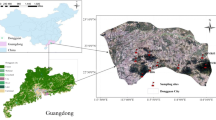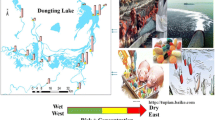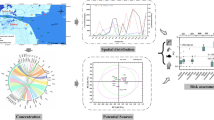Abstract
This study investigated the occurrence and variation of 11 antibiotics (including four sulfonamides (SAs), four fluoroquinolones (FQs), two tetracyclines (TCs), and one macrolide (ML)) and one SA synergist trimethoprim (TMP) in an artificial drinking water source reservoir in Yangtze River delta of East China. Water samples were collected each month from January to November in 2014 at the water inlet and outlet site of the reservoir. Sulfamethoxazole, sulfadiazine, and norfloxacin were detected with the high frequencies of 100, 92.31, and 97.85%, respectively. The total concentration showed the highest level in winter (229.14 ng/L) and the lowest one in summer (96.11 ng/L). FQs and TCs were the dominant species among all the antibiotics. The total amount of antibiotics detected in this reservoir showed a negative relationship with temperature (R2 = 0.7565) in this area. From the inlet site to outlet site of this reservoir, all SAs as well as TMP showed decline trends in the four seasons, but other antibiotics including FQs, TCs, and MLs increased more or less in different seasons, especially for ciprofloxacin in winter (from 48.82 ng/L at inlet site to 80.36 ng/L at outlet site). Most antibiotics detected in this drinking water source reservoir had no direct health risk for human with different age groups (except ciprofloxacin for the group of 0–3 months), but still showed obvious ecological risk for algae and invertebrate. Among the three target organisms (algae, invertebrate, and fish), algae was the most sensitive for antibiotics, which was followed by invertebrate. Among the target antibiotics, sulfamethoxazole, ciprofloxacin, tetracycline, and oxytetracycline showed high ecological risk for algae (RQs > 1), and oxytetracycline also showed high risk for invertebrate (RQ = 1.34).




Similar content being viewed by others
References
Batt AL, Kim S, Aga DS (2007) Comparison of the occurrence of antibiotics in four full-scale wastewater treatment plants with varying designs and operations. Chemosphere 68:428–435. https://doi.org/10.1016/j.chemosphere.2007.01.008
Carabineiro SAC, Thavorn-Amornsri T, Pereira MFR, Figueiredo JL (2011) Adsorption of ciprofloxacin on surface-modified carbon materials. Water Res 45:4583–4591. https://doi.org/10.1016/j.watres.2011.06.008
Carabineiro SAC, Thavorn-amornsri T, Pereira MFR, Serp P, Figueiredo JL (2012) Comparison between activated carbon, carbon xerogel and carbon nanotubes for the adsorption of the antibiotic ciprofloxacin. Catal Today 186:29–34. https://doi.org/10.1016/j.cattod.2011.08.020
Carvalho IT, Santos L (2016) Antibiotics in the aquatic environments: a review of the European scenario. Environ Int 94:736–757. https://doi.org/10.1016/j.envint.2016.06.025
Chen K, Zhou JL (2014) Occurrence and behavior of antibiotics in water and sediments from the Huangpu River, Shanghai, China. Chemosphere 95:604–612. https://doi.org/10.1016/j.chemosphere.2013.09.119
Cheng W, Jiang L, Lu N, Ma L, Sun X, Luo Y, Lin KF, Cui CC (2015) Development of a method for trace level determination of antibiotics in drinking water sources by high performance liquid chromatography-tandem mass spectrometry. Anal Methods 7:1777–1787. https://doi.org/10.1039/C4AY01654H
Cui C, ** L, Jiang L, Han Q, Lin K, Lu S, Zhang D, Cao G (2016) Removal of trace level amounts of twelve sulfonamides from drinking water by UV-activated peroxymonosulfate. Sci Total Environ 572:244–251. https://doi.org/10.1016/j.scitotenv.2016.07.183
Daghrir R, Drogui P (2013) Tetracycline antibiotics in the environment: a review. Environ Chem Lett 11:209–227. https://doi.org/10.1007/s10311-013-0404-8
Deng J, Shao Y, Gao N, **a S, Tan C, Zhou S, Hu X (2013) Degradation of the antiepileptic drug carbamazepine upon different UV-based advanced oxidation processes in water. Chem Eng J 222:150–158. https://doi.org/10.1016/j.cej.2013.02.045
DEQ (2005) Water Quality: Rules and Regulations, Chapter 17. Department of Environmental Quality (DEQ), Wyoming. Storage Tanks. http://deq.state.wy.us/shwd/stpSTPDownloads/Chapter_17.pdf
Dodd MC, Shah AD, von Gunten U, Huang CH (2005) Interactions of fluoroquinolone antibacterial agents with aqueous chlorine: reaction kinetics, mechanisms, and transformation pathways. Environ Sci Technol 39:7065–7076. https://doi.org/10.1021/es050054e
EPA US (2011) Exposure factors handbook. Washington DC. Available at http://www.epa.gov/ncea/efh/pdfs/efh-complete.pdf
FDA (2014) Summary report on antimicrobials sold or distributed for use in food-producing animals. In: Food and Drug Administration, Department of Health and Human Services: USA, Ed. Available at http://www.fda.gov/downloads/forindustry/userfees/animaldruguserfeeactadufa/ucm416983.pdf. Accessed 1 May 2015
Gaffney VJ, Almeida CMM, Rodrigues A, Ferreira E, Benoliel MJ, Cardoso VV (2015) Occurrence of pharmaceuticals in a water supply system and related human health risk assessment. Water Res 72:199–208. https://doi.org/10.1016/j.watres.2014.10.027
Gao P, Mao D, Luo Y, Wang L, Xu B, Xu L (2012) Occurrence of sulfonamide and tetracycline-resistant bacteria and resistance genes in aquaculture environment. Water Res 46:2355–2364. https://doi.org/10.1016/j.watres.2012.02.004
González-Pleiter M, Gonzalo S, Rodea-Palomares I, Leganés F, Rosal R, Boltes K, Marco E, Fernández-Pinas F (2013) Toxicity of five antibiotics and their mixtures towards photosynthetic aquatic organisms: implications for environmental risk assessment. Water Res 47:2050–2064. https://doi.org/10.1016/j.watres.2013.01.020
Greenberg BM, Huang XD, Dixon DG (1992) Applications of the aquatic higher plan Lemna gibba for ecotoxicological risk assessment. J Aquat Ecosyst Health 1:147–155
Guerard JJ, Chin YP, Mash H, Hadad CM (2009) Photochemical fate of sulfadimethoxine in aquaculture waters. Environ Sci Technol 43:8587–8592. https://doi.org/10.1021/es9020537
Hernando MD, Mezcua M, Fernandez-Alba AR, Barcelo D (2006) Environmental risk assessment of pharmaceutical residues in wastewater effluents, surface waters and sediments. Talanta 69:334–342. https://doi.org/10.1016/j.talanta.2005.09.037
Hu J, Wang W, Zhu Z, Chang H, Pan F, Lin B (2007) Quantitative structure–activity relationship model for prediction of genotoxic potential for quinolone antibacterials. Environ Sci Technol 41:4806–4812. https://doi.org/10.1021/es070031v
Hu J, Shi J, Chang H, Li D, Yang M, Kamogata Y (2008) Phenoty** and genoty** of antibiotic-resistant Escherichia coli isolated from a natural river basin. Environ Sci Technol 42:3415–3420. https://doi.org/10.1021/es7026746
Jiang L, Hu X, Yin D, Zhang H, Yu Z (2011) Occurrence, distribution and seasonal variation of antibiotics in the Huangpu River, Shanghai, China. Chemosphere 82:822–828. https://doi.org/10.1016/j.chemosphere.2010.11.028
Jiang L, Hu X, Xu T, Zhang H, Sheng D, Yin D (2013) Prevalence of antibiotic resistance genes and their relationship with antibiotics in the Huangpu River and the drinking water sources, Shanghai, China. Sci Total Environ 458-460:267–272. https://doi.org/10.1016/j.scitotenv.2013.04.038
Karthikeyan KG, Meyer MT (2006) Occurrence of antibiotics in wastewater treatment facilities in Wisconsin, USA. Sci Total Environ 361:196–207. https://doi.org/10.1016/j.scitotenv.2005.06.030
Kim SC, Carlson K (2007) Temporal and spatial trends in the occurrence of human and veterinary antibiotics in aqueous and river sediment matrices. Environ Sci Technol 41:50–57. https://doi.org/10.1021/es060737+
Kim S, Eichhorn P, Jensen JN, Weber AS, Age DS (2005) Removal of antibiotics in wastewater: effect of hydraulic and solid retention times on the fate of tetracycline in the activated sludge process. Environ Sci Technol 39:5816–5823. https://doi.org/10.1021/es050006u
Leung HW, Minh TB, Murphy MB, Lam JCW, So MK, Martin M (2012) Distribution, fate and risk assessment of antibiotics in sewage treatment plants in Hong Kong, South China. Environ Int 42:1–9. https://doi.org/10.1016/j.envint.2011.03.004
Li B, Zhang T (2010) Biodegradation and adsorption of antibiotics in the activated sludge process. Environ Sci Technol 44:3468–3473. https://doi.org/10.1021/es903490h
Li B, Zhang T (2012) pH significantly affects removal of trace antibiotics in chlorination of municipal wastewater. Water Res 46:3703–3713. https://doi.org/10.1016/j.watres.2012.04.018
Li W, Shi Y, Gao L, Liu J, Cai Y (2012) Occurrence of antibiotics in water, sediments, aquatic plants, and animals from Baiyangdian Lake in North China. Chemosphere 89:1307–1315. https://doi.org/10.1016/j.chemosphere.2012.05.079
Liu C, Nanaboina V, Korshin GV, Jiang W (2012) Spectroscopic study of degradation products of ciprofloxacin, norfloxacin and lomefloxacin formed in ozonated wastewater. Water Res 46:5235–5246. https://doi.org/10.1016/j.watres.2012.07.005
Luo Y, Xu L, Rysz M, Wang Y, Zhang H, Alvarez PJ (2011) Occurrence and transport of tetracycline, sulfonamide, quinolone, and macrolide antibiotics in the Haihe River basin, China. Environ Sci Technol 45:1827–1833. https://doi.org/10.1021/es104009s
Postigo C, Richardson SD (2014) Transformation of pharmaceuticals during oxidation/disinfection processes in drinking water treatment. J Hazard Mater 279:461–475. https://doi.org/10.1016/j.jhazmat.2014.07.029
Shanghai Statistics Bureau (2015) Shanghai Statistical Yearbook. China Statistics Press. Available at http://www.stats-sh.gov.cn/
Shi H, Yang Y, Liu M, Yan C, Yue H, Zhou J (2014) Occurrence and distribution of antibiotics in the surface sediments of the Yangtze estuary and nearby coastal areas. Mar Pollut Bull 83:317–323. https://doi.org/10.1016/j.marpolbul.2014.04.034
Tang J, Shi T, Wu X, Cao H, Li X, Hua R, Tang F, Yue Y (2015) The occurrence and distribution of antibiotics in Lake Chaohu, China: seasonal variation, potential source and risk assessment. Chemosphere 122:154–161. https://doi.org/10.1016/j.chemosphere.2014.11.032
Van Boeckel TP, Gandra S, Ashok A, Caudron Q, Grenfell BT, Levin SA, Laxminarayan R (2014) Global antibiotic consumption 2000 to 2010: an analysis of national pharmaceutical sales data. Lancet Infect Dis 14:742–750. https://doi.org/10.1016/S1473-3099(14)70780-7
Vieno NM, Harkki H, Tuhkanen T, Kronberg L (2007) Occurrence of pharmaceuticals in river water and their elimination in a pilot-scale drinking water treatment plant. Environ Sci Technol 41:5077–5084. https://doi.org/10.1021/es062720x
Wang P, He YL, Huang CH (2010) Oxidation of fluoroquinolone antibiotics and structurally related amines by chlorine dioxide: reaction kinetics, product and pathway evaluation. Water Res 44:5989–5998. https://doi.org/10.1016/j.watres.2010.07.053
Watkinson AJ, Murby EJ, Kolpin DW, Costanzo SD (2009) The occurrence of antibiotics in an urban watershed: from wastewater to drinking water. Sci Total Environ 407:2711–2723. https://doi.org/10.1016/j.scitotenv.2008.11.059
Xu Y, Guo C, Luo Y, Lv J, Zhang Y, Lin H, Li W, Xu J (2016) Occurrence and distribution of antibiotics, antibiotic resistance genes in the urban rivers in Bei**g, China. Environ Pollut 213:833–840. https://doi.org/10.1016/j.envpol.2016.03.054
Xue B, Zhang R, Wang Y, Liu X, Li J, Zhang G (2013) Antibiotic contamination in a typical develo** city in South China: occurrence and ecological risks in the Yongjiang River impacted by tributary discharge and anthropogenic activities. Ecotoxicol Environ Saf 92:229–236. https://doi.org/10.1016/j.ecoenv.2013.02.009
Yan C, Yang Y, Zhou J, Liu M, Nie M, Shi H, Gu L (2013) Antibiotics in the surface water of the Yangtze estuary: occurrence, distribution and risk assessment. Environ Pollut 175:22–29. https://doi.org/10.1016/j.envpol.2012.12.008
Yang SF, Lin CF, Lin AYC, Hong PKA (2011) Sorption and biodegradation of sulfonamide antibiotics by activated sludge: experimental assessment using batch data obtained under aerobic conditions. Water Res 45:3389–3397. https://doi.org/10.1016/j.watres.2011.03.052
Zhang Q, Jia A, Wan Y, Liu H, Wang K, Peng H, Dong Z, Hu J (2014) Occurrences of three classes of antibiotics in a natural river basin: association with antibiotic-resistant Escherichia coli. Environ Sci Technol 48:14317–14325. https://doi.org/10.1021/es503700j
Zhang QQ, Ying GG, Pan CG, Liu YS, Zhao JL (2015) Comprehensive evaluation of antibiotics emission and fate in the river basins of China: source analysis, multimedia modeling, and linkage to bacterial resistance. Environ Sci Technol 49:6772–6782. https://doi.org/10.1021/acs.est.5b00729
Zhou LJ, Ying GG, Zhao JL, Yang JF, Wang L, Yang B, Liu S (2011) Trends in the occurrence of human and veterinary antibiotics in the sediments of the Yellow River, Hai River and Liao River in northern China. Environ Pollut 159:1877–1885. https://doi.org/10.1016/j.envpol.2011.03.034
Acknowledgements
This work was supported by the National Water Pollution Control and Treatment Science and Technology Major Project (2017ZX07402003); China Postdoctoral Science Foundation (2017M621391); Shanghai Science and Technology Rising-Star Program, China (15QB1400700); Shanghai Municipal Science and Technology Commission (16DZ1204703); and Shanghai Tongji Gao Tingyao Environmental Science and Technology Development Foundation.
Author information
Authors and Affiliations
Corresponding author
Additional information
Responsible editor: Ester Heath
Electronic supplementary material
ESM 1
(DOCX 82 kb)
Rights and permissions
About this article
Cite this article
Cui, C., Han, Q., Jiang, L. et al. Occurrence, distribution, and seasonal variation of antibiotics in an artificial water source reservoir in the Yangtze River delta, East China. Environ Sci Pollut Res 25, 19393–19402 (2018). https://doi.org/10.1007/s11356-018-2124-x
Received:
Accepted:
Published:
Issue Date:
DOI: https://doi.org/10.1007/s11356-018-2124-x




